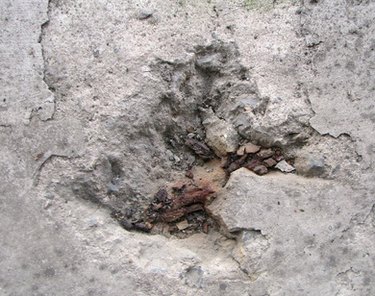Things You'll Need
Chemical concrete cleaner
Concrete degreaser
Stiff-bristled brush
Power washer
Joint repair sealant
Putty knife
Straightedge
Flashlight
Marker
Prybar
2x4 planks
Epoxy adhesive
Paintbrush
Self-leveling compound
Power drill
Mixing hook
Bucket
Trowel

Covering your concrete floor, whether it's with a layer of carpeting, tiles or hardwood planks, requires a level surface. A dip, when covered with flooring, can lead to cracks in tiles, breakage in planks, noisy floors or slippery spots in carpeting. Avoiding these problems requires that you level the dips before the new surface installation. One leveling solution is with the application of a self-leveling compound. These compounds are spread over the surface of your floor, filling dips and creating the level surface needed for the successful placement of flooring.
Step 1
Clean the concrete floor completely. Sweep the surface of the floor. Use a concrete degreaser on any area of the concrete that has oil stains, scrubbing away the stain using a stiff-bristled brush. Mop the floor using a chemical concrete cleaner. The cleaner will etch the floor slightly, increasing the adherence of the leveling compound. Wash away the residue of the cleaners, as well as any leftover dirt, using a power washer. Allow the floor to dry completely before continuing.
Video of the Day
Step 2
Fill any cracks in the floor with joint repair sealant, using a putty knife. Scrape the surfaces of the filled cracks with a putty knife to level them off. Allow the sealant to dry overnight.
Step 3
Locate the dips in the floor by placing a straightedge onto the surface and shining a flashlight beneath it. As you move the straightedge along the floor the light will shine underneath the bar to show dips in the floor. Mark these dips using a marker.
Step 4
Remove any trim or baseboards around the floor using a prybar. Place a wooden form around the edges of the floor to prevent the leveling compound from running outside the area. Wood forms can be made from 2x4s.
Step 5
Brush a layer of epoxy adhesive onto the surface of the floor using a paintbrush, to serve as a bonding agent between the existing surface and the compound. Allow the adhesive to dry to a tacky state without the wetness of newly laid glue.
Step 6
Mix a batch of self-leveling compound according to the manufacturer's instructions. Use a power drill with a mixing hook attached in a bucket to speed up mixing time. Self-leveling compounds generally must be applied within 20 minutes of mixing.
Step 7
Pour the compound into the marked dips of your floor, allowing the pooled mix to spread and fill the dips. Pour compound onto the remaining floor surface when the dips are filled. Spread the compound across the entire surface of the floor using a trowel. Allow the compound to set for four hours before walking on it, and for 24 hours before installing any additional flooring materials.
Tip
Use cold water to mix the self-leveling compound to extend the available working time of the material.
Video of the Day